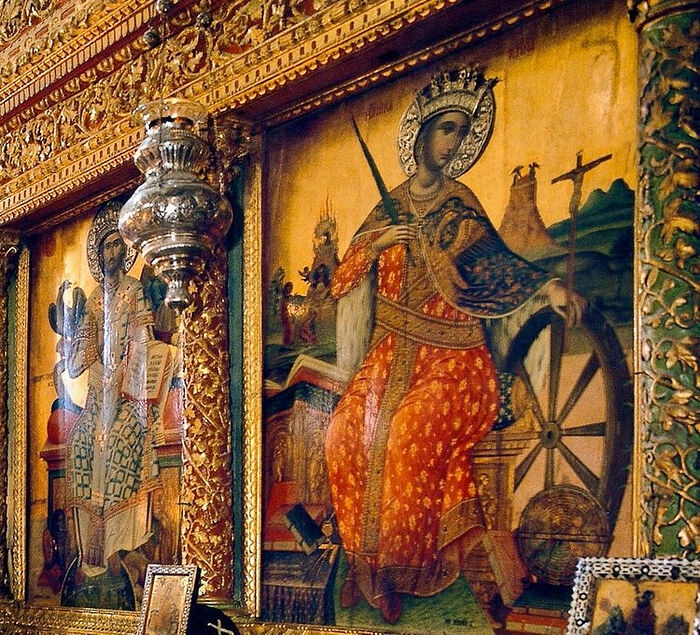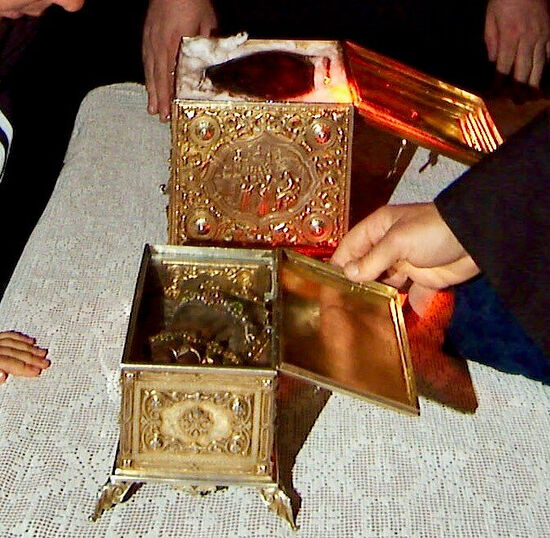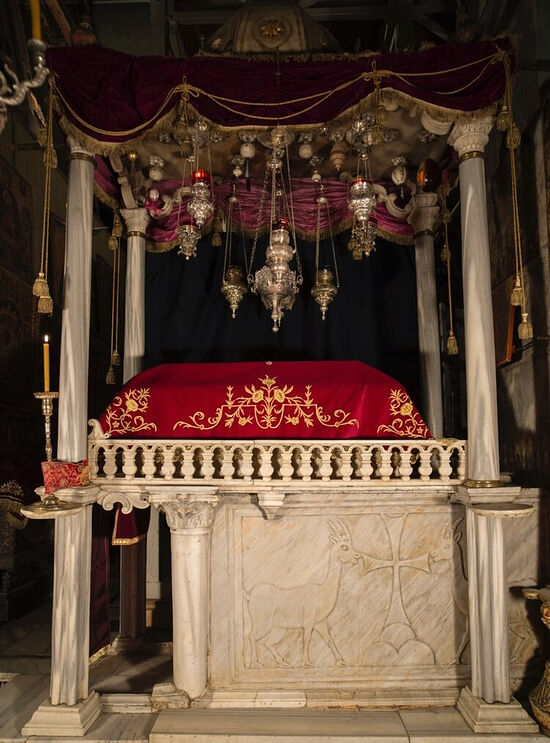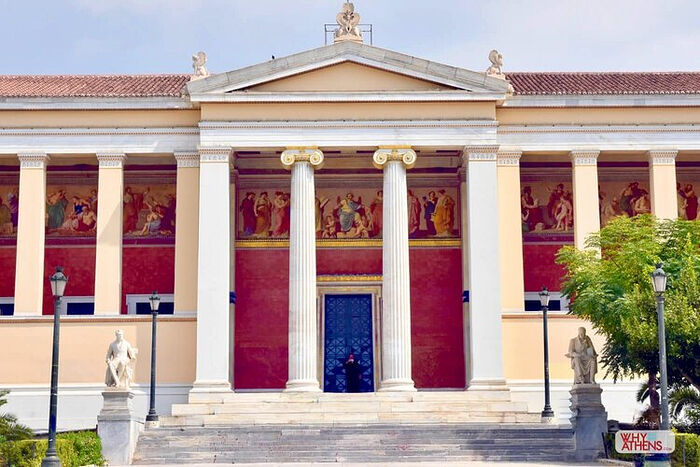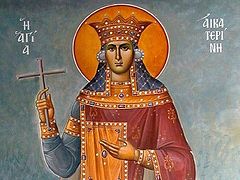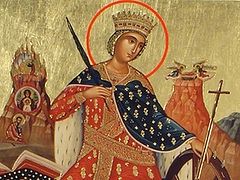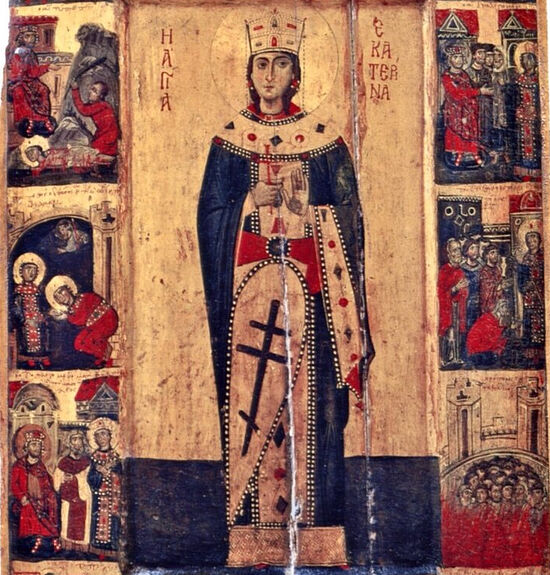 Saint Catherine with Scenes of Her Passion and Martyrdom, early 13th century.
Saint Catherine with Scenes of Her Passion and Martyrdom, early 13th century.
Saint Catherine’s life weaves an epic tapestry: born to a patrician family amidst idolatry, her quest for knowledge becomes the quest for truth which leads her to its Source, to whose love she voluntarily sacrifices youth, beauty, wealth, prestige and finally, the life she had not yet lived. One wonders about the inner motivations of the saints, but little more is known regarding what led to such sacrifice than her path to Christ through a Christian mother and Spirit-bearing elder named Onouphrios.
Given that Onouphrios was said to have come from the desert, this last is intriguing, for the cave of the fourth century Onouphrios the Great lies literally in the shadow of the summit where the relic of the Great-Martyr Saint Catherine was transported by angels in 305, not long after he had baptized her into Christianity. She also had two visions of Christ during her time with the elder. It was during the second of these that the infant Lord betrothed her to Himself as His bride forever, with a ring she found on her finger following the vision.
This all speaks volumes of a love for Christ beyond contemplation. Thus, this the question with which those who thirst for God absorbed: “How did she attain such heights?” The patristic saints are at no loss for words about such a pursuit. Even the ancients had understood the importance of living according to one’s inner light.
In Plato’s Republic, Socrates had already found the soul divided between reason, desire, and anger. Differences between people, indeed between peoples, were ascribed by the seer to whichever of these forces dominated the others in a person or population. The Athenians were ruled by knowledge; the Phoenicians, desire; while the impassioned Scythians were ready to fight. … Reason would ideally rule over anger and desire—an ambition supported by secular society to this day.
Taking a more deeply nuanced approach through their own, very different perspective, patristic sources find the model generally consistent with biblical revelation on the purification of the soul toward acquisition of the Holy Spirit.
For good or evil, desire generates the incensive power of anger that defends its sovereignty. Just separate a toddler from his toy to see the common essence of desire and anger… Pushing the limits of over-simplification: Desire for God, generating the anger that supports it, gives origin to the virtues (like humility) that free us from sin. Such anger stands sentry not just against sin, but against evil itself—forgiving and seeking forgiveness, until union with God fulfills the desire for Him breathed into our very creation.
The epic narrative of Saint Catherine’s brilliance portrays this when fifty pagan orators who debated with her beg forgiveness from God as the first step toward their own martyrdom for His love. The words, “Forgive me,” noted His Eminence, Archbishop Damianos of Sinai, are the conduit through which the grace of God reconciles the desire and action ever at war within us into the synergy that moves mountains.
No victory arrives easily in this life, and neither does this most exalted victory of all: progression from the image to the likeness of God that restores the divine attributes lost to human nature at the fall.
Not all are called to martyrdom. But all are called to incensive, courageous effort—for motion requires energy. Without the forces unleashed by anger like the hydroelectric power of water from a burst dam, what would empower the towering achievements of valor? Persistent, tenacious, indignant, unrelenting struggle is required for victory on the spiritual and every other front—for our weakened will is already exhausted by lesser pursuits … Who joyously boasts of discovering newfound time for prayer during pandemic lockdowns? Not many, perhaps. For one thing, those struggling for time to pray already knew where to find it… In an elevator, a waiting room, or stalled traffic.
Reason ruled the soul for the philosophers; for Orthodox Christianity, purified desire is the force that leads to knowledge—through its Source—by drawing us ever closer to the Word of God. Millions of saints have sacrificed everything to the heavenly Bridegroom Christ; none more memorably than the royal Bride who reigns beside Him on the opulent iconostasis of the world’s most celebrated monastery.
Purified by baptism into the Holy Trinity, “desire, anger and reason” synergized with the energies of Christ in the soul of Saint Catherine the Great Martyr of Alexandria to cast an enormous mountain into the sea—the immeasurable evil of idolatry.
* * *
Western culture considers Saint Catherine the patron saint of education due to her brilliance and extensive learning. For Orthodox Christianity, however, the Saint’s patronage points not to the worldly education she possessed, but to the infinitely more transcendent education conveyed by the authentic response of her entire life to the love of God.
With Onouphrios’ description of the perfections of Christ, Saint Catherine’s quest for truth is over. Without a pause, the object of her desire pivots—upon her love for truth—from “knowledge” to “God.” Through the ensuing struggle for His love—defending it to the intellectual elite of the empire while condemning their intellectual conceit—the intellect of a girl not yet twenty years old is filled with the grace of the Spirit. Her countenance radiating with Truth like the sun, Saint Catherine leaves the orators speechless by citing pagan texts that reveal the false gods of idolatry to be embodiments of the passions.
When you give in to passionate anger, know that you have worshipped Ares, the idol of war, concludes the account of the Saint’s life in the Great Synaxarion of the Orthodox Church. As for passions of the flesh, Aphrodite receives the veneration of those who succumb to them. And if you indulged in drunkenness, know that you sacrificed to Dionysios. What indeed is drunkenness but the disabling of intellect “sacrificed” to Dionysios? Do Ares and Aphrodite then not equally stand for the corruption of anger and desire?
Christians are therefore called to mimic the Saint not by shedding their blood, writes the author of the Synaxarion, but by conquering their idolatrous passions—for which they also will be crowned as martyrs. He’s a “grouch,” a “glutton”, a “drunkard,” they say. The passions to which we cede our free will then tyrannize over us to the point where we are known by them…
If every passion can be traced to corrupted desire, anger, or intellect—the patristic age’s “love of pleasure, glory and money”—Saint Catherine’s purification of the three divisions of soul suggests a greatly concerted attack on salvation. Is egotism not a form of desire? Pride—of inebriated anger? Avarice—of reason gone mad?
But the darkness is destroyed by the Light, and Christ Himself appeared to the Great Martyr while she was imprisoned, according to the Life of the Saint compiled by Symeon Metaphrastes in the tenth century. Shortly thereafter, when another Symeon, the Sinaite “Pentaglossos”, who spoke five languages, brought relics of Saint Catherine to Rouen, miracles precipitated her renown throughout Europe. If these were anything like the dramatic healings witnessed during the visit of her relics to Greece and Russia twenty-five years ago, then we know that Uncreated Light radiating from the Saint has never dimmed…
Originating from a marble reliquary housing the relics in Sinai’s great basilica, an ethereal fragrance has much to say of the union with God emanating from purified “desire, anger, and reason.” Wafting through the basilica overshadowed by Mount Sinai, its mystery whispers the first of these to be none other than the love for God “first” that thundered from its Summit as the first and greatest Commandment; the second—the courage that scorns the evil passions; and the third—the faith that acquires the indwelling of the Holy Spirit…
The years of Moses’ life witnessed by this desert navigate the same divisions of purification. Having killed an Egyptian, long struggle taught Moses to channel anger to the service of divine light rather than his own. Remembering Moses’s descent from Sinai, guarding the tablets inscribed by the finger of God for His people, who can quickly forget the image of the God-seer smashing these tablets to pieces as an indictment against the people’s faithlessness? The senseless golden calf (and its progeny in every age) worshipped as a god on one hand; on the other, Moses’ face shining so brightly that none could look on it…
Patristic writers point out that Moses shone with the Uncreated Light only exteriorly. Twelve centuries would pass before Christ’s crucifixion and resurrection opens the way for the intellect of the soul—its nous or innermost heart—to receive the Holy Spirit… (Thus the crucified Lord’s descent into Hades to offer salvation to those who had departed this life before participation in His death and resurrection, through holy baptism, extended the gift to all humanity.)
Thou shalt have no other gods beside Me.
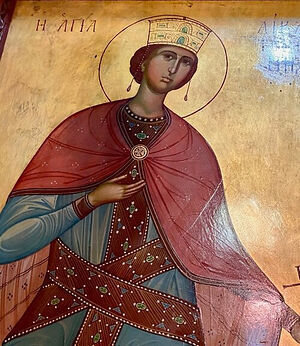 If it is safe to say that anger and understanding have their origin in desire—for good or evil—the kingdom of heaven depends on nothing so much as the return of that desire to God, whence it came… Orthodox life does not just consist of healing from the passions but of desire itself, as pointed out by the revered Cappadocian Protopresbyter of blessed memory, Father Stephanos Avramides of Boston and Athens.
If it is safe to say that anger and understanding have their origin in desire—for good or evil—the kingdom of heaven depends on nothing so much as the return of that desire to God, whence it came… Orthodox life does not just consist of healing from the passions but of desire itself, as pointed out by the revered Cappadocian Protopresbyter of blessed memory, Father Stephanos Avramides of Boston and Athens.
For it is one thing to choose the good, and another to want to do so. The holy ground of the Burning Bush singled out by Christ above every other as a fitting sanctuary for His Bride witnessed this lesson also: Had the Israelites not just fled the passions by fleeing idolatry through the Red Sea, where the waves stood up as walls to protect their passage and then closed in on the idolators? Nevertheless, as evinced by their backsliding to idol worship a short time later on Sinai, the “desire for God” remained elusive. Forty years of struggle would ensue before they would enter the promised land—the kingdom where genuine desire for God is fulfilled by His grace…
Exemplified by the choices of Saint Catherine, surely this is education at its highest: devotion of knowledge to the will of God, leading to the triumphs of every age that dare confront its prejudices …
The Holy Spirit Who proceeds from the Father acts in creation only through the Son.
Similarly, the virtues that proceed from desire act within us only through our struggle against evil—united with Christ’s infinitely greater “struggle against evil” on our behalf… Did the Son of God not become man for this very reason—to crown our struggle with victory?
From the days of John the Baptist until now, the kingdom of the heavens is taken by violence, and the violent seize it
If virtue proceeds from God-given desire, our sole responsibility is to keep desire pure. In short, nothing is required of us but to unite our energies to the divine energies of Christ. Fortunately, such synergy is made possible by the mysteries of the Orthodox Church, beginning with Holy Baptism in which we “put on Christ.” How else would we repel evil? Who practices violence from a position of weakness!
For, of course, there is no kind of evil capable of withstanding the omnipotent power of Christ—neither the evil that comes from the enemy of mankind to corrupt our desire, nor that which comes from our passions to corrupt our resistance to them, nor, indeed, that which comes from other people to corrupt our very faith in God, were it not kept safe within His embrace…
* * *
Standing opposite marble columns guarding the entrance to the University of Athens in all their neoclassical glory, a young man not typically given to musings granted them free rein one day. From the war-torn poverty that ripped tender youths from schoolroom to workroom, they turned toward the irrepressible dreams of an unwritten future. “What do you think, sister,” he queried the sibling by his side, “will we ever pass through those portals?”
The shadows of her own youth flattered no reckless hopes. “Us?? Not in your wildest dreams.”
Urban night schools provided the last educational hope for hundreds of thousands of working minors as post-war Greece struggled to its feet. As cities swelled with migration from provinces no longer able to feed their inhabitants on hard-scrabble agriculture, industry thrived on the surplus of cheap labor. Night schools were supposed to keep the children from losing out, even though odds on winning admittance to university were poor, and on completing a degree once there, poorer still. Attending classes only at night, pupils were held to the same performance standards on university entrance exams as the day students enjoying unlimited study and better resources, and whose education suffered no gaps from long interruptions. Even so, roughly a quarter of working children made the attempt.
Adults also attended the night schools, even though they were offered no accelerated timeline, and even had to attend class with the children. Amongst them was the brave young man, by now a military veteran, who paid no heed when friends and neighbors heaped scorn on his plans to resume an education aborted at sixth grade in order to work for his family. Apparently, the idea of a soldier newly discharged from military duty returning to twelve-year-old pursuits offended the general sense of propriety.
“But I was determined to study!” exclaimed Geronda Pavlos. “I wanted to learn what I could for the glory of God, and nobody could dissuade me. I went ahead with enrollment and worked through the seven-year course leading to a high school diploma. During the day I worked at construction sites. The work was considered demeaning. It was dirty and backbreaking, because my job was to carry bags of dry cement on my back to the tops of high-rise buildings under construction in central Athens. Friends passing by would recognize me covered with dust and dirt and pressure me to quit, assuring me there was no need to put myself through all this. But I persisted, because the work paid much better than other jobs; enough to pay my living expenses and tuition, send money home to my father, and also provide a dowry for my sister.
“High school diploma in hand, I considered the options. Dare I try for university? Convinced I didn’t have a chance given the competition from younger students who had gone to prestigious day schools with tutors and freedom to study full time, I decided there was nothing to lose by trying.”
Shortly afterwards, the same young man who had longed to pass through the neoclassic portals standing sentry over the School of Theology of the University of Athens did exactly that, having passed the entrance exam—in tenth place out of all who had competed that year.
* * *
If love gives birth to the courage that serves God, through which the nous is flooded with light (as the Father gives birth to the Son, through whom the Holy Spirit reveals His mysteries), love forms the secret of every success. Emphasizing the necessity for young people to have ideals and hold fast to them, the God-bearing Confessor of Sinai served Saint Catherine for five decades by dedicating his education and talents to the glory of God on the model of the Saint’s own life. Following in her footsteps by applying the energies of desire, anger, and intellect toward union with God, the hesychast elder needed very few words to convey all of the above: “We were created to love.”
What comes first, then: the love that begins in God (then reaches ourselves, then goes out to all others, as described by the elder)? Or the desire that draws us to Him? Before ever stepping onto the stage of martyrdom and history, Saint Catherine proves the answer to be neither. Love for God consists of desire for Him. Love for self—of the anger repelling attempts to separate us from Him. Love for others—of the purified intellect with a luminous faith that draws them to Christ.
Confounded by the rhetorical skills of the courageous martyr’s light-filled nous, the empire’s academic elite were brought to the Saint’s feet to admit the deceit of idol worship. Seeking Baptism into Christ, they were assured by His Bride that the fire of martyrdom will itself become their Baptism. It will be the ladder leading them to the kingdom of heaven as luminous stars, and to its King as His beloved friends—which it proceeds to do without scorching a hair on their heads. Besides the intellectuals, hundreds of soldiers chose a martyrs’ crown, together with their commander Porphyrios and the emperor’s wife Faustina.
In the face of threats and tortures, how does Saint Catherine remain the unshakeable inspiration for so many? We are offering insist through eyes of her disciple, Faustina. Moved by the vision of the Saint’s face shining so brightly that no one could look upon it, the empress secretly visited her in prison. There she decided to exchange her earthly reign for the heavenly one, but confesses her fear of martyrdom. Promising Faustina that she will have Christ “within her heart” to help her, Catherine reveals the dwelling-place of Christ in the heart of her own soul, reconciling its forces with His own. But this is not all.
Faustina’s decision to renounce a visible, earthly kingdom in favor of an invisible, merely promised one—throwing “reason” to the winds—signifies that not only does she sense the divine energies supporting the struggle of Saint Catherine over the several days of her martyrdom, but that Faustina herself has become a participant in this synergy. Souls communicate in God on a level that deductive logic will never understand, and Saint Catherine’s genius was to lead those around her to their own mystical union with Christ. Divine love is fulfilled not only in her own soul, but in the souls of those who come into contact with it…
It was at this point that Geronda Pavlos discerned the boundary forever dividing philosophy from Christianity, whose truth, he emphasized, remains inseparable from love, and therefore, from life. As the elder put it, you can love philosophy without becoming an idol worshipper. But you cannot love Christ without becoming a Christian.
To the glory of God, the All-Pure, All-Wise, Great Martyr and Bride of Christ, Saint Catherine the Great of Alexandria, has shown us how this works, to the ages of endless ages.
Photography Courtesy of Massimo Pizzocaro (Donato, Italy http://www.pizzocaro.com) and Hieromonk Justin, Librarian, St. Catherine’s Monastery. Article used with permission.

